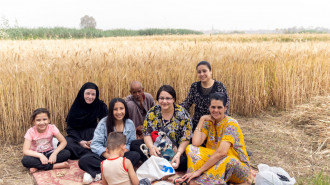![Qatar's Emir Sheikh Tamim bin Hamad al-Thani arrives for the UN Climate Change Conference COP26 at SECC on November 1, 2021 in Glasgow, Scotland. 2021 sees the 26th United Nations Climate Change Conference [Getty Images]](/sites/default/files/styles/image_360x240/public/2021-11/GettyImages-1236269450.jpg?h=199d8c1f&itok=IX7sh0EL)
'One of the biggest challenges of our time': Evaluating Qatar's performance at COP26
![Qatar's Emir Sheikh Tamim bin Hamad al-Thani arrives for the UN Climate Change Conference COP26 at SECC on November 1, 2021 in Glasgow, Scotland. 2021 sees the 26th United Nations Climate Change Conference [Getty Images]](/sites/default/files/styles/image_360x240/public/2021-11/GettyImages-1236269450.jpg?h=199d8c1f&itok=IX7sh0EL)
Since the start of November, the 26th United Nations Climate Change Conference, or COP26, has dominated the news headlines as world leaders sought to tackle the growing climate emergency.
Almost 200 countries were represented at the COP26, with negotiations continuing for two weeks. Yet, despite relentless deliberation, no ‘strong deal’ was reached. Crucially, the leaders of both China and Russia were not present at the event, choosing to rather send a delegation of officials.
According to an International Energy Agency (IEA) report this year, the energy sector produces three-quarters of greenhouse gas emissions globally and it “holds the key to averting the worst effects of climate change.” With that being the case, such statistics put further pressure upon the Middle Eastern energy industry to either divest away from fossil fuels or to find greener solutions.
"COP 26 still left a large political gap between those countries with large economies leading the cause for green energy transition and developing countries, especially those with hydrocarbon resources, that are being asked to forego those resources without a sufficient cooperation for an alternative"
Though they are often blamed for contributing a sizable amount of carbon emissions themselves, most of the Gulf Cooperation Council (GCC) states can be said to have participated at COP26 with great enthusiasm.
Attending the COP summit himself, Qatar’s Amir Sheikh Tamim bin Hamad Al Thani joined world leaders to discuss climate change, accompanied by a large delegation of Qatari activists and experts.
Around the same time as the COP26, the Qatar Foundation for Education, Science and Community Development (QF) also announced a long-term partnership with Rolls-Royce to create a global centre for climate technology innovation.
Appreciating that the GCC states had shown interest, the UN climate chief, Patricia Espinosa said, “We need countries to come to COP with a high level of ambition,” noting that the Gulf countries’ net-zero commitments were “a powerful signal at the right moment”.
Espinosa continues in saying that "GCC states want to continue extracting and exporting hydrocarbons for as long as it makes economic sense to do so- in other words, for as long as there is global demand-while trying to reduce the industry’s environmental impact with measures to limit or offset CO2 emissions. Accordingly, GCC countries’ climate policies focus on adaptation, not mitigation".
This was not always the case, as Cinzia Bianco, a visiting fellow at the European Council on Foreign Relations highlighted recently in her paper, GCC states had usually given a limited response to climate change as in her opinion, energy revenues were “existentially important to their economies.”
Among the hottest places in the world, the GCC states, which comprise: Bahrain, Kuwait, Oman, Qatar, Saudi Arabia and the UAE will face the severe consequences of climate change much sooner than most countries. This year, Kuwait registered one of the highest temperatures on record.
Most of the Gulf states have initiated their own climate change plans yet often have been considered somewhat ambiguous. While top-oil exporter Saudi Arabia committed that it would reach net-zero emissions by 2060 and invest around $186 billion in building a ‘green economy’, Bahrain's target was 2050 with investments worth $163 billion.
Along with Qatar and Kuwait, these states happen to be among the top 10 carbon dioxide emitters per capita, according to statistics retrieved from the World Bank. Meanwhile, Oman intends to reduce its emissions by 7 percent by 2030, much less than the recommended 50 percent.
The UAE has opted to go for nuclear energy and sustainable transport instead. Also, three GCC states, the UAE, Bahrain and Oman, are part of a group of 47 countries committed to creating climate-resilient, low-carbon systems at the cop conference.
However, most of these GCC states have not provided details yet on how they would achieve these goals. In particular, another complication is that net-zero carbon objectives do not account for the oil and gas that gets exported and then used by other countries.
Qatar’s steps to fight Climate Change
Notably, Qatar is the world’s largest producer of liquefied natural gas but combating climate change has been a newfound priority for Doha. Including climate change in its National Vision 2030, this long-term policy was brought in line with the UN Sustainable Development Goals (SDGs).
Some significant initiatives have been taken by Doha.
"While COP26 may have fallen short of expectations, it is largely due to richer countries exerting their political and financial clout, with smaller countries having to compromise"
First, the One Million Trees Planting Initiative, which began in 2019, is set to be completed before the start of the 2022 Fifa World Cup. Linked to the global sporting event, Qatar aims to have 20-25 percent of public transport as environmentally friendly.
Second, just weeks before the COP summit, Doha established a Ministry of Environment and Climate Change. Explaining Qatar’s stance at a presser at COP26, the Environment Minister Abdulla bin Abdulaziz bin Turki Al Subaei said, “Qatar considers climate change to be one of the biggest challenges of our time, which calls for urgent and dedicated measures at the local, regional and global levels.” Qatar has launched a Climate Change Action Plan as part of its pledge to reduce its greenhouse gas emissions by 25 percent by 2030.
As said by Deputy Prime Minister and Minister of Foreign Affairs Sheikh Mohammed bin Abdulrahman Al Thani, “NCCAP sets a clear roadmap on how Qatar will meet its international commitments to help fight the causes and mitigate the effects of manmade climate change, and in particular to reducing emissions of greenhouse gases.” With this in mind, Qatar Energy (QE) plans to reduce the carbon intensity of LNG facilities by 25 percent by 2030.
Third, Qatar has a National Environment and Climate Change Strategy covering five areas: greenhouse gas emissions, air quality, biodiversity, water, circular economy, waste management and land use. With this plan, the Qatar Food Security Strategy also gets extended with further green spaces to be added.
Finally, at COP 26, Qatar’s Gulf Organization for Research & Development (GORD) announced the launch of a Green Events Tool (GET) in collaboration with UN climate change platforms to help evaluate and reduce the carbon footprint of events.
Whilst COP26 may have fallen short of expectations, it is largely due to richer countries exerting their political and financial clout, with smaller countries having to compromise.
When discussing the overall impact of the climate summit with The New Arab, Professor Michael Tanchum, a senior fellow at the Austrian Institute for European and Security Policy and a non-resident fellow in the economics and energy programme at the Middle East Institute in Washington, DC, observed that “COP 26 still left a large political gap between those countries with large economies leading the cause for green energy transition and developing countries, especially those with hydrocarbon resources, that are being asked to forego those resources without a sufficient cooperation for an alternative.”
Sabena Siddiqui is a foreign affairs journalist, lawyer, and geopolitical analyst specialising in modern China, the Belt and Road Initiative, the Middle East, and South Asia.
Follow her on Twitter: @sabena_siddiqi



